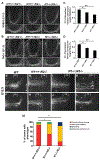Ndfip Proteins Target Robo Receptors for Degradation and Allow Commissural Axons to Cross the Midline in the Developing Spinal Cord
- PMID: 30893602
- PMCID: PMC6913780
- DOI: 10.1016/j.celrep.2019.02.080
Ndfip Proteins Target Robo Receptors for Degradation and Allow Commissural Axons to Cross the Midline in the Developing Spinal Cord
Abstract
Commissural axons initially respond to attractive signals at the midline, but once they cross, they become sensitive to repulsive cues. This switch prevents axons from re-entering the midline. In insects and mammals, negative regulation of Roundabout (Robo) receptors prevents premature response to the midline repellant Slit. In Drosophila, the endosomal protein Commissureless (Comm) prevents Robo1 surface expression before midline crossing by diverting Robo1 into late endosomes. Notably, Comm is not conserved in vertebrates. We identified two Nedd-4-interacting proteins, Ndfip1 and Ndfip2, that act analogously to Comm to localize Robo1 to endosomes. Ndfip proteins recruit Nedd4 E3 ubiquitin ligases to promote Robo1 ubiquitylation and degradation. Ndfip proteins are expressed in commissural axons in the developing spinal cord and removal of Ndfip proteins results in increased Robo1 expression and reduced midline crossing. Our results define a conserved Robo1 intracellular sorting mechanism between flies and mammals to avoid premature responsiveness to Slit.
Keywords: Commissureless; E3 ubiquitin ligase; Ndfip; Nedd4; Robo; Slit; axon guidance; midline; repulsion; spinal cord.
Copyright © 2019 The Authors. Published by Elsevier Inc. All rights reserved.
Conflict of interest statement
DECLARATION OF INTERESTS
The authors declare no competing interests.
Figures







Similar articles
-
Commissureless acts as a substrate adapter in a conserved Nedd4 E3 ubiquitin ligase pathway to promote axon growth across the midline.Elife. 2025 May 23;13:RP92757. doi: 10.7554/eLife.92757. Elife. 2025. PMID: 40407164 Free PMC article.
-
A Nedd4 E3 Ubiquitin Ligase Pathway Inhibits Robo1 Repulsion and Promotes Commissural Axon Guidance across the Midline.J Neurosci. 2022 Oct 5;42(40):7547-7561. doi: 10.1523/JNEUROSCI.2491-21.2022. Epub 2022 Aug 24. J Neurosci. 2022. PMID: 36002265 Free PMC article.
-
Conserved and divergent aspects of Robo receptor signaling and regulation between Drosophila Robo1 and C. elegans SAX-3.Genetics. 2021 Mar 31;217(3):iyab018. doi: 10.1093/genetics/iyab018. Genetics. 2021. PMID: 33789352 Free PMC article.
-
Axon guidance at the midline of the developing CNS.Anat Rec. 2000 Oct 15;261(5):176-97. doi: 10.1002/1097-0185(20001015)261:5<176::AID-AR7>3.0.CO;2-R. Anat Rec. 2000. PMID: 11058217 Review.
-
Roundabout receptors.Adv Neurobiol. 2014;8:133-64. doi: 10.1007/978-1-4614-8090-7_7. Adv Neurobiol. 2014. PMID: 25300136 Review.
Cited by
-
Molecular mechanisms regulating axon responsiveness at the midline.Dev Biol. 2020 Oct 1;466(1-2):12-21. doi: 10.1016/j.ydbio.2020.08.006. Epub 2020 Aug 17. Dev Biol. 2020. PMID: 32818516 Free PMC article.
-
A tug of war between DCC and ROBO1 signaling during commissural axon guidance.Cell Rep. 2023 May 30;42(5):112455. doi: 10.1016/j.celrep.2023.112455. Epub 2023 May 5. Cell Rep. 2023. PMID: 37149867 Free PMC article.
-
Transcriptional Control of Axon Guidance at Midline Structures.Front Cell Dev Biol. 2022 Feb 21;10:840005. doi: 10.3389/fcell.2022.840005. eCollection 2022. Front Cell Dev Biol. 2022. PMID: 35265625 Free PMC article. Review.
-
The E3 ubiquitin ligase ITCH negatively regulates intercellular communication via gap junctions by targeting connexin43 for lysosomal degradation.Cell Mol Life Sci. 2024 Apr 10;81(1):171. doi: 10.1007/s00018-024-05165-8. Cell Mol Life Sci. 2024. PMID: 38597989 Free PMC article.
-
Commissureless acts as a substrate adapter in a conserved Nedd4 E3 ubiquitin ligase pathway to promote axon growth across the midline.Elife. 2025 May 23;13:RP92757. doi: 10.7554/eLife.92757. Elife. 2025. PMID: 40407164 Free PMC article.
References
-
- Ambrozkiewicz MC, and Kawabe H (2015). HECT-type E3 ubiquitin ligases in nerve cell development and synapse physiology. FEBS Lett 589, 1635–1643. - PubMed
-
- Blockus H, and Chédotal A (2014). The multifaceted roles of Slits and Robos in cortical circuits: from proliferation to axon guidance and neurological diseases. Curr. Opin. Neurobiol 27, 82–88. - PubMed
-
- Brose K, Bland KS, Wang KH, Arnott D, Henzel W, Goodman CS, Tessier-Lavigne M, and Kidd T (1999). Slit proteins bind Robo receptors and have an evolutionarily conserved role in repulsive axon guidance. Cell 96, 795–806. - PubMed
Publication types
MeSH terms
Substances
Grants and funding
LinkOut - more resources
Full Text Sources
Other Literature Sources
Molecular Biology Databases

